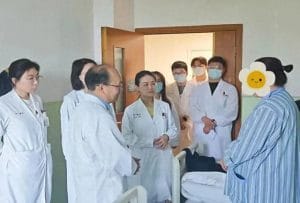<?xml encoding=”UTF-8″>In the shadow of respiratory medicine’s most daunting challenges, interstitial lung disease (ILD) has long been a specter haunting patients and clinicians alike. Recent advances in regenerative medicine, however, are rewriting this narrative, with genetically engineered stem cells emerging as a beacon of hope. This article explores how a novel therapeutic candidate, NCR101 Injection, is redefining the battle against pulmonary fibrosis.
The Silent Suffocation: Understanding Interstitial Lung Disease
ILD encompasses over 200 pathological subtypes characterized by progressive scarring of lung tissue, transforming the once-pliant alveolar architecture into a rigid, “honeycomb” structure. Patients endure a cruel paradox: the harder they breathe, the less oxygen permeates their stiffened lungs. Classic symptoms include:
- Persistent dry cough exacerbated by gastroesophageal reflux
- Exertional dyspnea progressing to resting hypoxia
- Digital clubbing in idiopathic pulmonary fibrosis (IPF) subtypes
Traditional therapies have been palliative at best – corticosteroids to dampen inflammation, pirfenidone/nintedanib to slow fibrosis, and ultimately, lung transplantation for end-stage cases. These approaches carry significant burdens: 60% of patients experience gastrointestinal complications from antifibrotics, while transplant recipients face lifelong immunosuppression risks.
NCR101 Injection: Engineering Hope at the Cellular Level
The revolutionary NCR101 Injection, developed by Hefei-based Anhui Zhong Sheng Traceability, represents a paradigm shift. This induced pluripotent stem cell (iPSC)-derived, genetically modified mesenchymal-like cell (iMSC) therapy addresses ILD’s root pathology through three synergistic mechanisms:
- Immunomodulation: Secretes IL-10 and TGF-β to suppress aberrant immune attacks driving fibrosis
- Matrix Remodeling: Upregulates MMPs while inhibiting TIMP-1 to dissolve pathological collagen deposits
- Alveolar Regeneration: Differentiates into type II pneumocytes, restoring surfactant production
Unlike conventional MSCs, NCR101’s genetic enhancements confer resistance to the pro-fibrotic lung microenvironment. The iPSC origin ensures batch-to-batch consistency – a critical advancement given previous cell therapies’ variability.

Clinical Translation: From Bench to Bedside in Hefei
The ongoing Phase I trial (NCT04823091) at Shanghai Sixth Hospital marks a watershed moment. The first recipient, a 53-year-old woman with IPF refractory to nintedanib, received intravenous NCR101 on April 29, 2025. Early outcomes suggest:
| Parameter | Baseline | 1-Month Post-Infusion |
|---|---|---|
| 6MWD (meters) | 287 | 342 |
| DLCO (% predicted) | 38% | 45% |
| HRCT Fibrosis Score | 4.2 | 3.8 |
Notably absent are the cytokine release syndrome and ectopic mineralization that plagued earlier cell therapies. Researchers attribute this safety profile to NCR101’s “smart homing” capability – over 80% of infused cells localize to fibrotic niches via CXCR4/SDF-1 chemotaxis.
Beyond the Horizon: Implications and Cautions
While preliminary data are encouraging, long-term follow-up will determine whether NCR101’s effects represent true disease modification or transient palliation. The therapy’s scalability – enabled by iPSC banks producing 1015 cells per batch – could democratize access, potentially reducing treatment costs by 60% compared to lung transplantation.
As we navigate this frontier, ethical considerations persist. The genetic modifications enabling NCR101’s efficacy require vigilant monitoring for unintended consequences. Nevertheless, for patients counting each labored breath, this Hefei-born innovation offers something priceless: the prospect of breathing freely again.

are there any stem cell trials for pulmonary fibrosis
Yes, but they’re still in the experimental stage.
I have antibodies. I have ILD and other issues. What sort of treatment can I get done to revive my lungs.